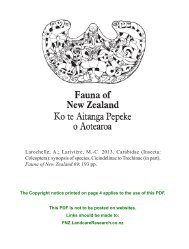Fauna of NZ 45 - Landcare Research
Fauna of NZ 45 - Landcare Research
Fauna of NZ 45 - Landcare Research
Create successful ePaper yourself
Turn your PDF publications into a flip-book with our unique Google optimized e-Paper software.
52 Kuschel (2003): Nemonychidae, Belidae, Brentidae (Insecta: Coleoptera)<br />
30. Crossvein a 2 -a 3 . Present (0); absent (1). Individual<br />
variations in the wing venation occur and discrepancies<br />
even in the two wings <strong>of</strong> the same specimen may be<br />
noticed on occasions. The crossvein a 2 -a 3 is usually<br />
present, though the length may vary (see next character)<br />
and it may be absent where veins a 2 and a 3 are fused at<br />
their bases (Fig. 49).<br />
31. Crossvein a 2 -a 3 . Present as a relatively long vein (0);<br />
rudimentary (1); inapplicable for taxa coded as 30-1.<br />
Samples <strong>of</strong> a long a 2 -a 3 are shown in Fig. 46–48, 59–53<br />
[correct fig???]. No figure is provided for a crossvein<br />
<strong>of</strong> state (1), but it is considered rudimentary if the<br />
crossvein is only about as long as wide.<br />
32. Shared track <strong>of</strong> A 1 +A 2 apicad <strong>of</strong> a 2 -a 3 or junction <strong>of</strong> the<br />
shared track with A 3 . Long (0); short (1). This character<br />
separates Pachyurini and Belini. Vanin’s (1976) Figure<br />
23 for Trichophthalmus, showing a long shared track,<br />
is at odds with our observations and Fig. 56.<br />
33. Vein A 1 . Complete (0); interrupted or absent (1). This<br />
vein is consistently interrupted in Agnesiotidini (Fig.<br />
50–53) and two species <strong>of</strong> New Zealand Pachyurini<br />
(Fig. 49) and absent only among the taxa surveyed in<br />
Rhicnobelus metallicus.<br />
34. Direction and distance <strong>of</strong> a 3 -a 4 in relation to cu-a.<br />
Oblique and distant (0); transverse and close (1). There<br />
is no figure here provided to illustrate this character.<br />
State 1 is peculiar to Apagobelus and Basiliobelus.<br />
35. Position <strong>of</strong> procoxae. Slightly postmedian (0); slightly<br />
antemedian (1). The position <strong>of</strong> the procoxae relative<br />
to the front and hind margin <strong>of</strong> the prothorax<br />
distinguishes the two tribes Belini and Pachyurini.<br />
36. Sides <strong>of</strong> pro- and mesocoxae. Partially or entirely open<br />
(0); completely closed (1). The coxal cavities are<br />
completely closed if the lobes that enclose the coxae<br />
show not even an indentation at the suture. In state 0<br />
the lobes leave at least a triangular gap right next to the<br />
coxae. Closed coxal cavities may constitute a strong<br />
apomorphy for Agnesiotidini.<br />
37. Length <strong>of</strong> hind femora in relation to hind margin <strong>of</strong><br />
ventrite 2. Passing it (0); at most reaching it (1). This<br />
character may be useful for separating the tribes Belini<br />
and Pachyurini.<br />
38. Crenulated ridge on laterodorsal surface <strong>of</strong> tibiae.<br />
Absent (0); present (1). Tibiae must be seen at the<br />
right light and turn to be certain <strong>of</strong> the presence or<br />
absence <strong>of</strong> the ridge. A crenulated ridge is present in all<br />
taxa <strong>of</strong> Belini and Agnesiotidini.<br />
39. Tibial formula <strong>of</strong> spurs. 2-2-2 (0); 1-2-2 (1). Spurs are<br />
always distinct and hardly ever different in size on the<br />
middle and hind tibiae. If the protibiae have two spurs,<br />
these may be small and <strong>of</strong> uneven length, and could be<br />
missing from a tibia because <strong>of</strong> breakage.<br />
40. Denticulation on lower edge <strong>of</strong> tibiae. Absent (0);<br />
present (1). Presence <strong>of</strong> denticulation on the protibiae<br />
is observed in all Belini and in over half <strong>of</strong> the terminal<br />
taxa <strong>of</strong> Pachyurini selected, but the denticulation is<br />
sometimes rather fine (e.g., R. metallicus).<br />
41. Mucro on fore and/or middle tibia in male. Absent (0);<br />
present (1). Among the taxa considered, a mucro is<br />
absent only in Agathinus, Cyrotyphus, and Pachyurinus.<br />
42. Spines on lower edge on one or more femora. Absent<br />
(0); one spine present (1); two or more spines present<br />
(2). Having femoral teeth is a feature <strong>of</strong> the<br />
Agnesiotidini (except in odd males <strong>of</strong> Atractuchus<br />
annulifer argus) and the vast majority <strong>of</strong> Belini.<br />
43. Pedon and tectum <strong>of</strong> aedeagus. Free throughout (0); at<br />
least partially fused to a tubular structure (1). This<br />
character invariably separates the two recognised tribes.<br />
44. Basal and guide sclerites in internal sac. Absent (0);<br />
present (1). A basal sclerite is absent from Macrobelus,<br />
Pachyura, and Sphinctobelus, the remainder <strong>of</strong><br />
Pachyurini have a rigid basal sclerite, apart from other<br />
small sclerites.<br />
<strong>45</strong>. Form <strong>of</strong> basal and guide sclerites in internal sac. Basal<br />
sclerite present as a rigid ‘flagellum’ (0); basal and a<br />
long sclerite with a snare-like structure when viewed in<br />
pr<strong>of</strong>ile (1). Belini have a very strange sclerite illustrated<br />
by Zimmerman’s (1994) Figure 216a with a<br />
conspicuous ‘snare’. The South American genera<br />
Homalocerus and Trichophthalmus have a weakly<br />
sclerotised guide-sclerite much like that <strong>of</strong> Stenobelus<br />
illustrated in Figure 235 <strong>of</strong> Zimmerman (1994).<br />
46. Length <strong>of</strong> parameral sector relative to apodeme. Shorter<br />
or equal (0); distinctly longer (1). A long parameral<br />
sector is a salient feature for Agnesiotidini.<br />
47. Length <strong>of</strong> spermathecal duct relative to hemisternites.<br />
As long as or longer than hemisternites (0); very short,<br />
sessile, or subsessile (1). All Belinae examined have a<br />
thick and short spermathecal duct, but some among<br />
these may be as long as or even a little longer than the<br />
hemisternites.<br />
48. Median or postmedian spots <strong>of</strong> elytra. Absent (0);<br />
present (0). Rhinotia haemoptera has spots, but these<br />
are more laterally placed on the elytra and are<br />
considered not homologous to those present in<br />
Atractuchus annulifer, Dicordylus binotatus, D.<br />
marmoratus, and Rhinotia bidentata.
















